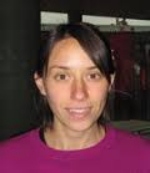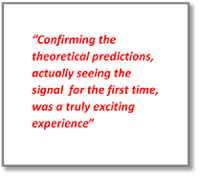 In this thesis electrical detection in liquids is investigated, using high-frequency signals. This new approach overcomes screening phenomena due to mobile salt ions, which makes electrostatic sensing of a target analyte further than a few nanometers from an electrode essentially impossible.
In this thesis electrical detection in liquids is investigated, using high-frequency signals. This new approach overcomes screening phenomena due to mobile salt ions, which makes electrostatic sensing of a target analyte further than a few nanometers from an electrode essentially impossible.
‘Close collaboration with NXP Semiconductors was decisive here,’ Cecilia Laborde says. They provided the sensing platform which consisted in a high-density array of nanoelectrodes integrated with standard CMOS electronics on a single chip. In this way a range of high-frequency impedance spectroscopy measurements could be performed.
‘The project was very exciting,’ Cecilia says. ‘In literature no experiments like these were referred to. We measured signals no one ever measured before.’
Electrochemical biosensors are attractive due to their ease of integration, miniaturization and cost-effective parallelization. ‘The NXP-device provides a tool to explore experimentally new regimes of the spectra that were unreachable with nanoelectrodes up to now,’ Cecilia Laborde explains. A novel array consisting of 256x256 nanocapacitors-electrodes, integrated on a chip, enabled multiple real-time analyses in liquid samples.
Deeper understanding

Laborde: ‘We analyzed the advantages of high-frequency impedance spectroscopy with measurements focused on the detection and imaging of microparticles in a wide range of solution compositions. By modifying the ionic strength and testing analytes with different electrical properties, we aimed to gain a deeper understanding of the physics underlying the detection mechanism.’

Laborde was able to show that the sensor response really depended on the electrical properties of the analyte, allowing impedance-based fingerprinting. ‘This opened new spectra of data, new behaviour to be analyzed, and new physics was involved,’ Laborde says. ‘By using high-frequency signals we were able to really see beyond the screening layers, into the fluid. Confirming the theoretical predictions, actually seeing the signal for the first time, was a truly exciting experience.’
Experimental boundaries
Regarding the detection of smaller objects, gaining a clear signal - and evidence of actual binding – from a 28 nm in diameter particle, was a milestone in Cecilia’s PhD project. ‘We succeeded to explore the experimental boundaries of this complex project,’ she says. ‘That was a surprising and satisfactory result. Above that, we could come up with clear suggestions how to further improve this novel device.’ Therefore, in the final chapter of the thesis, an outlook of future development of this technique is given.
Collaborations

The quest to detect smaller sizes and further penetrating and inspecting solution samples, led to new collaborations for the Mesa+ Nanoionics Group, led by Professor Serge Lemay, which Cecilia is a member of. Within the University of Twente the detection platform was used to detect biological samples such as viruses and their empty capsids, which were provided by the Biomolecular NanoTechnology group, led by Professor Jeroen Cornelissen.
In collaboration with Wageningen University further detection of biological entities such as cells were performed. ‘Simulation experts from Università Degli Studi di Udine were of prime importance as well,’ Cecilia says. ‘With their help I gained more insights in the processes and phenomena in this new field of research, and how to design clever experiments.’
Post-doc

In a post-doc period of six months, following her Defence, Cecilia will perform some extra experiments and work on some new articles.
Cecilia: ‘The support I got from my research group, NanoLab technicians, and from NXP experts as well, was great. They helped me to persevere if I was alone in the lab. I learnt to be patient and confident while searching for results, but also to move on or change direction when needed. I really enjoyed this adventurous research project. In a future job I strive this dynamics of research to be present, working on intriguing issues, be it in industry or in academics.’
